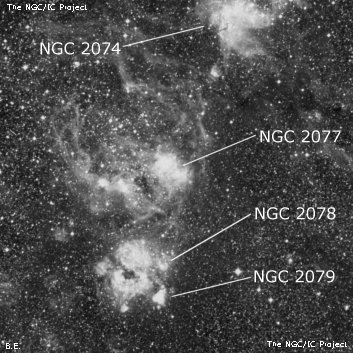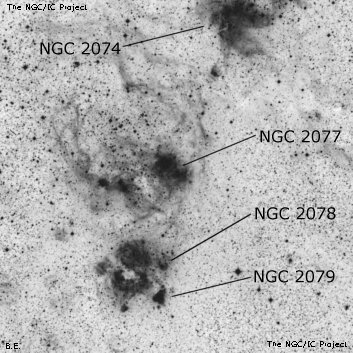NGC/IC Project Restoration Effort
(This is a very very beta version)
NGC2077


Basic Information
Location and Magnitude
Right Ascension: 5:39:36.0
Declination: -69:39:26
Constellation: DOR
Visual Magnitude:
Historic Information
Discoverer: Dunlop
Year of discovery: 1826
Discovery aperture: 9.0
Observational
Summary description: F, R, p of D neb
Sub-type: EN
Corwin's Notes
=====
NGC 2077 and other objects in its area (NGC 2078, 2079, 2080, 2083, 2084,
2085, and 2086) are parts of a large star cloud (star-forming region)
containing many HII regions and young star clusters. JH sketched it on
4 December 1837, and included the sketch as Plate III, figure 4 in his CGH
Observations. The plate shows a dozen knots of nebulosity, but JH included
only eight in CGH, so these are all that received GC and NGC numbers. Some of
his positions for these eight are derived from the sketch, and all are pretty
good. I've given positions for his other four in the main table.
Steve's Notes
=====
NGC 2077
24" (4/9/08 - Magellan Observatory, Australia): this is the southwest component of a very bright, impressive 2' emission patch with NGC 2080. At 200x and UHC filter, NGC 2077 appeared bright, moderately large, elongated 2:1 E-W, ~1.2'x0.6'. Without a filter, three fainter stars are involved in the glow (one is a massive Wolf-Rayet star). Forms a close pair of with NGC 2080 (Ghost Head Nebula) 1.1' NE.
NGC 2085 and 2086, a smaller pair of bright HII glows, lie 3' and 4' ESE, and the entire collection forms LMC-N160. In addition, a bright complex of HII knots including NGC 2078, 2079, 2083 and 2084 (LMC-N159 and O-association LW 105) lies 5' S. Together these groups form a stunning field about 35' SSE of the Tarantula Nebula.



